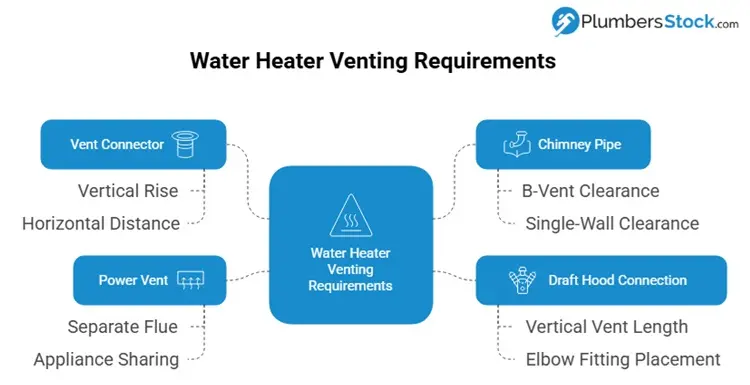When installing a gas-fueled water heater in your home, you’re going to think through the project before you tackle it. One primary consideration is, what are your gas water heater venting options? We’ll cover each venting type individually, as well as requirements and some potential water heater venting problems that you may find.
Water Heater Vent Types

There are two components to venting. Your water heater needs to exhaust flue gases safely, and it must also draw fresh air in. Since the exhaust contains carbon dioxide, it must be vented outside. Here are your three options:
- Atmospheric vent
- Power vent
- Direct vent
Atmospheric
If you have an atmospheric venting system, your exhaust vents naturally. What this means is that because of its buoyancy, the exhaust will escape through a vertical pipe, often into a chimney, where it can then leave the home for good. The air used for combustion draws from the atmosphere inside the house (or garage). Atmospheric is the most common gas water heater venting option. The primary issue with atmospheric vent systems is that they are susceptible to backdrafts (more on that later).
“Atmospheric vent water heaters must be connected to a vertical, gravity-vented flue that terminates above the roofline, using Type B vent pipe. Proper draft is critical to ensure combustion gases rise naturally and do not backdraft into the home.” – Bradford White Installation & Operation Manual
Key Points About Atmospheric Vent Water Heaters:
- Natural Draft Venting: These systems rely on gravity and hot air rising to vent combustion gases through a vertical flue — no fan or electricity required.
- Chimney Required: Must be vented vertically through a chimney or Type B vent pipe that extends above the roofline, limiting placement flexibility.
- No Electricity Needed: Because there are no powered components, atmospheric models continue to operate during power outages.
- Lower Upfront Cost: Typically, the most affordable type of gas water heater in terms of both equipment and installation.
- Simple Design: Fewer moving parts mean less can go wrong, resulting in long-term reliability and easier maintenance.
- Greater Backdraft Risk: Since there’s no fan to assist exhaust, proper venting and draft are crucial to avoid combustion gases spilling back into the home.
- Limited Efficiency: Most atmospheric units fall short of high-efficiency standards due to standby heat loss and less controlled combustion.
Power

If you have a power-vent configuration, it means that your water heater uses a mechanical fan to move air. A few advantages here are that you can vent either vertically or horizontally, and you can install the water heater a considerable distance from the termination point (usually as much as 150′). You can install this type in homes with no chimney.
Whether you have a tank or tankless water heater, you need to vent with stainless steel or metal pipe due to the high temperatures. The only way to avoid this is with a condensing unit, which will allow you to vent with PVC.
“Power vent water heaters use an electric blower fan to push exhaust gases through horizontal or vertical venting, allowing for flexible installation and eliminating the need for a traditional chimney.” – A. O. Smith, Gas Water Heater Vent Configurations Guide
Key Points About Power Vent Water Heaters:
- Electric Blower Required: A built-in fan pushes exhaust gases out of the home, allowing for more flexible venting compared to atmospheric models.
- Horizontal or Vertical Venting: Power vent units can be vented through the side wall or roof using PVC, CPVC, or ABS pipe, making them ideal for homes without chimneys.
- Requires Electricity: These units won’t function during power outages unless backed up by a generator or battery, as the blower relies on electric power.
- Reduced Backdraft Risk: Active exhaust reduces the likelihood of combustion gases entering the home, offering improved safety over passive venting.
- Longer Vent Runs Allowed: The fan-assisted design supports extended vent lengths and more routing options during installation.
- Higher Installation Cost: While offering more flexibility, power vent systems tend to cost more up front and require a nearby electrical outlet.
- Audible Operation: The blower motor produces a mild humming noise during use, which may be a consideration for noise-sensitive areas.
Direct
With direct vent installations, there is a sealed combustion chamber and a flue pipe. They can vent separately or together through a double-wall pipe. Compared to atmospheric, direct-vent water heaters offer more installation flexibility because they can vent horizontally. They also operate more quietly than their power-venting counterparts.
“Direct vent water heaters use a sealed combustion system that draws air from outside the home and vents exhaust gases directly back out, typically through a horizontal pipe. This makes them ideal for tight spaces and energy-efficient homes, as they don’t rely on indoor air for combustion.” – Rheem Professional Water Heater Installation Guide
Key Points About Direct Vent Systems:
- Sealed System: Unlike atmospheric and power vent models, a direct vent system doesn’t interact with indoor air, which improves indoor air quality and combustion safety.
- Horizontal Venting: Exhaust and intake are handled through coaxial or two-pipe PVC venting, usually installed through an exterior wall.
- High Efficiency: Many models qualify as high-efficiency due to sealed combustion and reduced standby heat loss.
- No Electricity Needed (in most models): Since some models don’t require a blower, direct vent units can operate during a power outage, unlike power-vented units.
For more general inquiries about water heaters, you may want to check out this Wikipedia page.
Gas Hot Water Heater Venting Problems

One problem you need to avoid is back-drafting. You typically see this most commonly with atmospheric configurations, which means that your exhaust is not leaving the home. Back-drafting is usually the result of an inadequate vent design. Look for the signs:
- Corrosion at the top of the water heater
- Melted plastic at the top, near the draft hood
- Condensation
You can also run a manual test. Isolate the water heater by closing doors and windows, shutting off the furnace, and allowing the water heater to run independently. If you feel warm air near the draft hood, then your system is back-drafting.
Water Heater Venting Requirements
The trick is to provide the right amount of size, height, and draft in your ventilation. Here a list of some bare minimum requisites but do not accept this as comprehensive. You will need to review all local and state codes that apply to you and observe them.

- When venting vertically through the roof, you must often use a vent connector. Please be aware that it must have a rise of 1/4″ per 12″ of horizontal run. It’s not much of a slope, so compliance isn’t usually that difficult. The total horizontal distance cannot be more than 75% of the vertical distance.
- Typically, B-Vent chimney pipe requires 1″ clearance, but there is zero-clearance pipe available. For a single-wall pipe, you need 6″ clearance, and you cannot pass it through a ceiling, floor, or wall unless it’s masonry or concrete (non-combustible).
- For the draft hood connection, you need to allow for at least 12″ of vertical vent before throwing an elbow fitting in the line.
- If you have a power vent water heater, do not share the flue with other appliances.
Check Out Other Helpful Guides
Related resources:
Video: Ensure Proper Venting
Lighting a Gas Water Heater in 7 Steps
Gas Water Heater Installation
Water Heater Thermocouple Replacement in 5 Steps
How to Clean Thermocouple On Water Heater
How to Turn On Hot Water Heater
About the Author
Cliff is a proud Dad and already a Grandpa, if you can believe it! He likes to lift weights, play basketball, hunt, and do just about anything outside. He has been in the construction and plumbing business off and on since 1989 and has tons of experience in many areas of home improvement.
